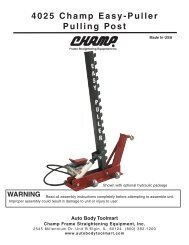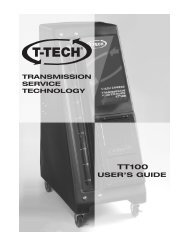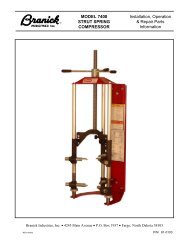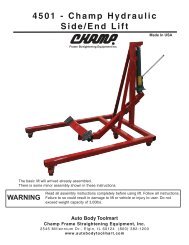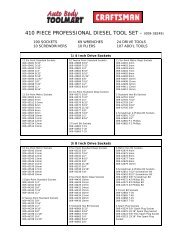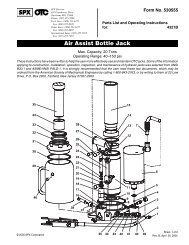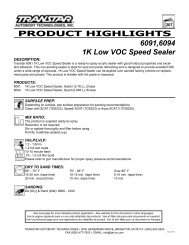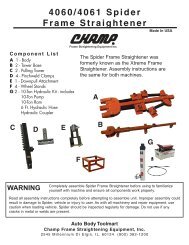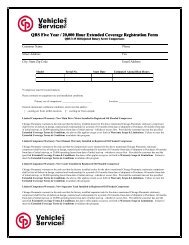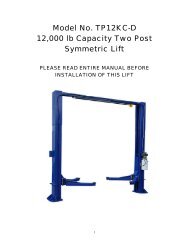to download the Evercoat Metal Glaze Ultra MSDS - Auto Body ...
to download the Evercoat Metal Glaze Ultra MSDS - Auto Body ...
to download the Evercoat Metal Glaze Ultra MSDS - Auto Body ...
You also want an ePaper? Increase the reach of your titles
YUMPU automatically turns print PDFs into web optimized ePapers that Google loves.
MATERIAL SAFETY DATA SHEETDate Revised: 12-13-12 Page: 1<strong>Metal</strong> <strong>Glaze</strong> <strong>Ultra</strong> <strong>MSDS</strong> Number: 130114SECTION 1. CHEMICAL PRODUCT AND COMPANY IDENTIFICATIONMaterial IdentityProduct Name:<strong>Metal</strong> <strong>Glaze</strong> <strong>Ultra</strong>Product Numbers: 100424, 100425Product Use:Polyester Finishing and Blending PuttyCompanyEmergency Telephone Numbers:ITW <strong>Evercoat</strong> CHEMTREC: 1-800-424-9300a Division of Illinois Tool Works Inc. CANUTEC: 1-613-996-66666600 Cornell RoadCincinnati, Ohio USAPhone: 513-489-7600Prepared By: Safety DepartmentSECTION 2. COMPOSITION / INFORMATION ON INGREDIENTSIngredient(s) CAS Number EINECS Number % (by weight)Polyester Resin (Non- Proprietary Proprietary 30 – 35Hazardous)Styrene 100-42-5 202-851-5 20 – 25Calcium CarbonateTalc1317-65-314807-96-6215-279-6238-877-915 – 2015 – 20Glass EnamelMagnesite65997-17-3546-93-0266-046-0208-915-95 – 101– 5Titanium Dioxide 13463-67-7 236-675-5 1– 3OSHA Regula<strong>to</strong>ry Status: This material is classified as hazardous under OSHA regulations.SECTION 3. HAZARDS IDENTIFICATION***EMERGENCY OVERVIEW***WARNING! FLAMMABLE LIQUID AND VAPOR.CAUSES EYE, SKIN, NOSE AND THROAT IRRITATION.Potential Health EffectsAcute Effects (Short Term):Eye: Contact with liquid or vapor may result in irritation, redness, tearing,and blurred vision.Skin: May cause mild skin irritation. Prolonged or repeated contact maydry <strong>the</strong> skin. Symp<strong>to</strong>ms may include redness, burning, drying andcracking of skin, and skin burns.Swallowing: Ingestion of this material may cause gastrointestinal irritation,nausea, diarrhea, and vomiting. Aspiration of this material in<strong>to</strong> <strong>the</strong>lungs due <strong>to</strong> vomiting may produce chemical pneumonitis whichcan be fatal.
MATERIAL SAFETY DATA SHEETDate Revised: 12-13-12 Page: 2<strong>Metal</strong> <strong>Glaze</strong> <strong>Ultra</strong> <strong>MSDS</strong> Number: 130114Inhalation: Excessive inhalation of vapors may cause nasal and respira<strong>to</strong>ryirritation, acute nervous system depression, fatigue, weakness,nausea, headache, and dizziness. Symp<strong>to</strong>ms usually occur at airconcentrations higher than <strong>the</strong> recommended exposure limits (SeeSection 8).Chronic Effects of Overexposure (Long Term):Styrene: Excessive overexposure <strong>to</strong> styrene has been found <strong>to</strong> cause <strong>the</strong>following effects in humans and may aggravate pre-existingdisorders of <strong>the</strong>se organs; central nervous system effects, effectson hearing, mild effects on color vision and respira<strong>to</strong>ry tractdamage.Cancer Information: Styrene is listed as “reasonably anticipated <strong>to</strong> be a humancarcinogen” in <strong>the</strong> U.S. Dept. of Health and Human Services National ToxicologyProgram’s 12 th report on carcinogens. The International Agency for Research onCancer (IARC) has classified styrene as a group 2B carcinogen (possiblycarcinogenic <strong>to</strong> humans). This classification is not based on evidence thatstyrene may be carcinogenic, but ra<strong>the</strong>r on a revised definition for Group 2B, andconsideration of new data on styrene oxide (Group 2A). Titanium Dioxide is listedby IARC as possibly carcinogenic <strong>to</strong> humans (Group 2B). This listing is based oninadequate evidence of carcinogenicity in humans and sufficient evidence inexperimental animals. This material may contain trace amounts of chemicalsconsidered <strong>to</strong> be carcinogenic by OSHA, (1, 3- Butadiene-IARC Group 2A andCrystalline Silica- IARC Group 1).O<strong>the</strong>r Health Effects: NOTICE: Reports have associated repeated and prolongedoccupational overexposure <strong>to</strong> solvents with permanent brain and nervous systemdamage. Intentional misuse by deliberately concentrating and inhaling <strong>the</strong>contents may be harmful or fatal.Primary Route(s) of Entry: Inhalation, Skin contact, Eye contact, Ingestion,skin absorption.SECTION 4. FIRST AID MEASURESEyes:Skin:Flush eyes gently with water for at least 15 minutes. Seekimmediate medical attention.Remove contaminated clothing. Wash exposed area with soap andwater. If symp<strong>to</strong>ms persist, seek medical attention. Launderclothing before reuse.
MATERIAL SAFETY DATA SHEETDate Revised: 12-13-12 Page: 3<strong>Metal</strong> <strong>Glaze</strong> <strong>Ultra</strong> <strong>MSDS</strong> Number: 130114Swallowing: Consult a physician or poison control center immediately. DO NOTINDUCE VOMITING. If individual is drowsy or unconscious, do notgive anything by mouth; place individual on <strong>the</strong> left side with <strong>the</strong>head down. If possible, do not leave individual unattended.Inhalation:If symp<strong>to</strong>ms develop, immediately move individual away fromexposure and in<strong>to</strong> fresh air. Seek immediate medical attention;keep person warm and quiet. If person is not breathing, beginartificial respiration. If breathing is difficult, oxygen may be benificialif administered by trained personnel.SECTION 5. FIRE FIGHTING MEASURESFlash Point: 89.0 ºF (31.6ºC)Explosive Limit: Lower: 1.1% Upper: 6.1%Au<strong>to</strong>ignition Temperature: 914.0 ºF (490.0 ºC)OSHA Flammability Class: Flammable Liquid – Class ICHazardous Products of Combustion: May form: carbon dioxide, carbonmonoxide, styrene oxide, and various hydrocarbons.Fire and Explosion Hazards: Vapors are heavier than air and may travel along<strong>the</strong> ground or may be moved by ventilation and ignited by pilot lights, o<strong>the</strong>rflames, sparks, heaters, smoking, electric mo<strong>to</strong>rs, static discharge, oro<strong>the</strong>r ignition sources at locations distant from material handling point.Extinguishing Media: Regular foam, carbon dioxide, dry chemical.Fire Fighting Instructions: Water may be used <strong>to</strong> keep fire-exposed containerscool until fire is out. Wear a self-contained breathing apparatus NIOSHapproved with a full facepiece operated in <strong>the</strong> positive pressure demandmode with appropriate turn-out gear and chemical resistant personalprotective equipment.NFPA Rating: Health - 2, Flammability - 3, Reactivity - 2SECTION 6. ACCIDENTAL RELEASE MEASURESIn Case of Spill: Eliminate all sources of ignition such as flares, flames (includingpilot lights), and electrical sparks. Ventilate <strong>the</strong> area. Wear proper protectiveequipment (Section 8). Avoid breathing vapors. Collect with an inert absorbantand dispose of properly.SECTION 7. HANDLING AND STORAGE
MATERIAL SAFETY DATA SHEETDate Revised: 12-13-12 Page: 4<strong>Metal</strong> <strong>Glaze</strong> <strong>Ultra</strong> <strong>MSDS</strong> Number: 130114Handling: All hazard precautions given in <strong>the</strong> data sheet must be observed. Avoidcontact with eyes, skin and clothing. Wash thoroughly after handling. Use only withadequate ventilation. Do not brea<strong>the</strong> sanding dust, vapors or spray mist. Do not takeinternally. Close container after each use. KEEP OUT OF REACH OF CHILDREN.S<strong>to</strong>rage: S<strong>to</strong>re material in a cool, well-ventilated area. For maximum productquality, avoid prolonged s<strong>to</strong>rage at temperatures above 75°F (25°C). Do not use ors<strong>to</strong>re near heat, sparks, or open flame. Keep container tightly closed. Avoid contact withincompatible materials.SECTION 8. EXPOSURE CONTROLS/PERSONAL PROTECTIONEye Protection:Skin Protection:Chemical splash goggles in compliance with OSHA regulations arerecommended.Protective gloves and proper clothing should be worn <strong>to</strong> preventskin contact. Gloves should be made of neoprene or natural rubber.To prevent repeated or prolonged skin contact, wear imperviousclothing and boots.Respira<strong>to</strong>ry Protection: Use a NIOSH approved respira<strong>to</strong>r designed <strong>to</strong> removeparticulate matter and organic solvent vapors.Engineering Controls: Provide sufficient mechanical (general and/or local exhaust)ventilation <strong>to</strong> maintain exposure below acceptable limits.Explosion-proof ventilation system is acceptable.Exposure Guidelines:Hazardous Ingredients CAS Number OSHA PEL/TWA ACGIH TLVCalcium Carbonate 1317-65-3 15 mg/m 3 10 mg/m 3Glass Enamel 65997-17-3 5 mg/m 3 10 mg/m 3Styrene 100-42-5 100 ppm 20 ppmTalc 14807-96-6 20 mppcf 2 mg/m 3Titanium Dioxide 13463-67-7 15 mg/m 3 10 mg/m 3Mppcf- millions of particles per cubic foot of air N/E-Not EstablishedSECTION 9. PHYSICAL AND CHEMICAL PROPERTIESBoiling Point: 293 °F/ 145 °C(Styrene)Vapor Density:Specific Gravity / 0.96 / 8.0 lbs/gal Percent Volatiles byDensity:weight:Heavier than air.20 - 25 %
MATERIAL SAFETY DATA SHEETDate Revised: 12-13-12 Page: 5<strong>Metal</strong> <strong>Glaze</strong> <strong>Ultra</strong> <strong>MSDS</strong> Number: 130114Evaporation Rate: Slower than ethyl Physical State:Thick Liquide<strong>the</strong>r.Melting Point: -23.1 °F / -30.6 pH:Neutral°C (Styrene)Odor:Sharp, aromatic Solubility:Insoluble in water.odor.Vapor Pressure: 5.0 mmHg @ 68 Appearance:Green LiquidOctanol/WaterPartition Coeff.:°F / 20 °C(Styrene) UnknownVOC (as packaged-less exempts andwater):Percent Solids byweight – aspackaged:VHAP Content byweight – aspackaged:1.67 lbs/gal or200g/LVOC (as applied*- 2%bywt hardener- lessexempts and water):79.6 % Percent Solids byweight – as applied* - 2% by wt hardener:21.0 % VHAP Content byweight – as applied* - 2% by weight hardener:0.05lbs/gal or5g/L99.4 %6.2 %*NOTE: The applied VOC and VHAP Content is lower than <strong>the</strong> packaged VOC andVHAP Content due <strong>to</strong> a reactive diluent (styrene) that reacts and becomes non-volatile(bonded in <strong>the</strong> solid material) when <strong>the</strong> hardener is added.SECTION 10. STABILITY AND REACTIVITYHazardous Polymerization: Product may undergo hazardous polymerizationif exposed <strong>to</strong> extreme heat.Hazardous Decomposition: May form: carbon dioxide, carbon monoxide,styrene oxide and various hydrocarbons.Chemical Stability: Stable under normal handling conditions.Incompatibility: Avoid contact in uncontrolled conditions with: peroxides,strong acids, strong oxidizing agents and polymerization catalysts.SECTION 11. TOXICOLOGICAL INFORMATIONAcute Toxicity Data:Ingredient CAS # LD 50 Oral-Rat LC 50 Inhalation-RatStyrene 100-42-5 5,000 mg/kg 24 g/m 3 /4HCalcium Carbonate 1317-65-3 6,450 mg/kg N/EN/E-Not EstablishedCarcinogenicity: See Cancer Information, Section 3.Mutagenicity: No significant evidence found.
MATERIAL SAFETY DATA SHEETDate Revised: 12-13-12 Page: 6<strong>Metal</strong> <strong>Glaze</strong> <strong>Ultra</strong> <strong>MSDS</strong> Number: 130114Tera<strong>to</strong>genicity: No significant risk of birth defects or reproductive <strong>to</strong>xicity ofstyrene <strong>to</strong> humans.SECTION 12. ECOLOGICAL INFORMATIONEco<strong>to</strong>xicity: Styrene is <strong>to</strong>xic <strong>to</strong> aquatic organisms and should not be released<strong>to</strong> sewage, draining systems or any body of water exceedingconcentrations of approved limits under applicable regulations andpermits.SECTION 13. DISPOSAL CONSIDERATIONRCRA Hazardous Waste: This material as supplied, if discarded,would be regulated as a hazardous waste under RCRA (40 CFR 261).Dispose of in accordance with applicable federal, state, and localregulations.RCRA Hazard Class: This material would be regulated as EPA HazardousWaste Number D001 based on <strong>the</strong> characteristic of ignitablity.SECTION 14. TRANSPORT INFORMATIONDOT Description: The DOT Classification for shipping is dependent onquantity, type of packaging (a kit may include o<strong>the</strong>r components), ormethod of shipment.SECTION 15. REGULATORY INFORMATIONUS Federal RegulationsTSCA (Toxic Substances Control Act) StatusTSCA (USA) The intentional ingredients of this product are listed.CERCLA RQ - 40 CFR 302.4(a)ComponentRQ (lbs.)Styrene 1000SARA Title III: Section 302- Extremely Hazardous SubstancesNoneSARA Title III: Section 313- Toxic Chemical ListComponent CAS Number PercentageStyrene 100-42-5 21.0 %EPA Hazardous Air Pollutants (HAPS) 40 CFR 63Component CAS Number PercentageStyrene 100-42-5 21.0 %International RegulationsEINECS (Europe) The intentional ingredients of this product are listed.DSL (Canada) The intentional ingredients of this product are listed.
MATERIAL SAFETY DATA SHEETDate Revised: 12-13-12 Page: 7<strong>Metal</strong> <strong>Glaze</strong> <strong>Ultra</strong> <strong>MSDS</strong> Number: 130114WHMIS ClassificationHealth Hazard: D2A, D2B (O<strong>the</strong>r Toxic Effects)Physical Hazard: B2 (Flammable)State and Local RegulationsCalifornia Proposition 65:This product contains <strong>the</strong> following chemical(s) known <strong>to</strong> <strong>the</strong> state ofCalifornia <strong>to</strong> cause cancer. Styrene Oxide, 1,3-Butadiene, Crystalline Silica,Titanium DioxideStyrene, in <strong>the</strong> presence of air and high temperature or prolongedexposure of styrene/air mixture <strong>to</strong> sunlight, can react <strong>to</strong> form styreneoxide.This product contains <strong>the</strong> following chemical(s) known <strong>to</strong> <strong>the</strong> state ofCalifornia <strong>to</strong> cause birth defects or reproductive harm. 1,3-BUTADIENESECTION 16. OTHER INFORMATIONHMIS Rating: Health – 2*, Flammability - 2, Reactivity - 2Key- 0=Least, 1=Slight, 2=Moderate, 3=Serious, 4=Extreme, *=Chronic EffectsO<strong>the</strong>r Precautions for Use: This product must be mixed with Cream Hardenerprior <strong>to</strong> use. Please refer <strong>to</strong> <strong>the</strong> Material Safety Data Sheet (#100340) for catalystbefore using. If product is <strong>to</strong> be sanded, <strong>the</strong> OSHA PEL/TLV of 10 mg/m 3 fornuisance dust should be observed.Additional Information may be obtained by calling <strong>the</strong> <strong>Evercoat</strong> <strong>MSDS</strong> Hotline at1-800-729-7600.NOTICE: The information accumulated herein is believed <strong>to</strong> be correct as of <strong>the</strong> date issued fromsources, which are believed <strong>to</strong> be accurate and reliable. Since it is not possible <strong>to</strong> anticipate allcircumstances of use, recipients are advised <strong>to</strong> confirm, in advance of need, that <strong>the</strong> informationis current, applicable and suitable <strong>to</strong> <strong>the</strong>ir circumstances.



